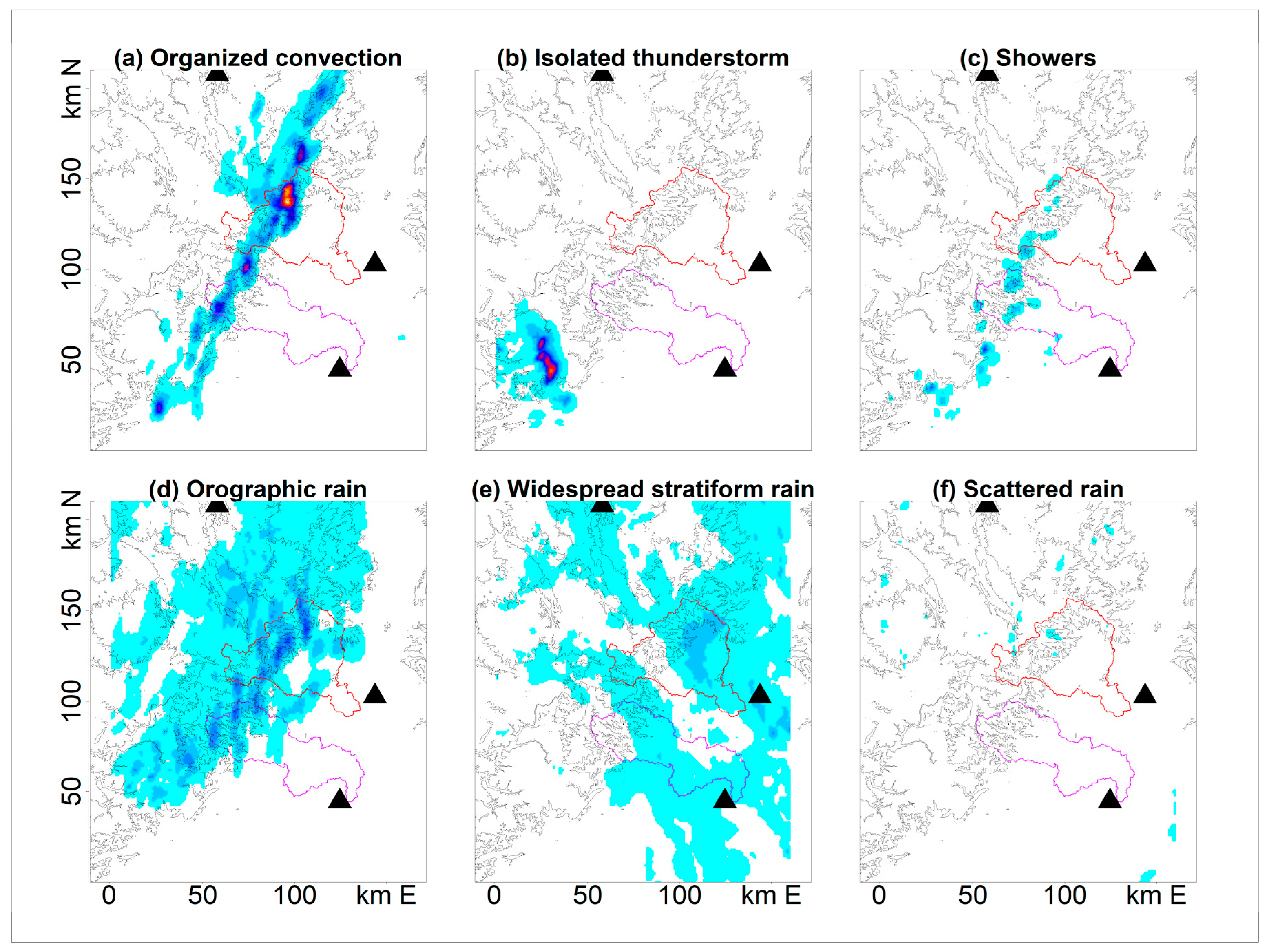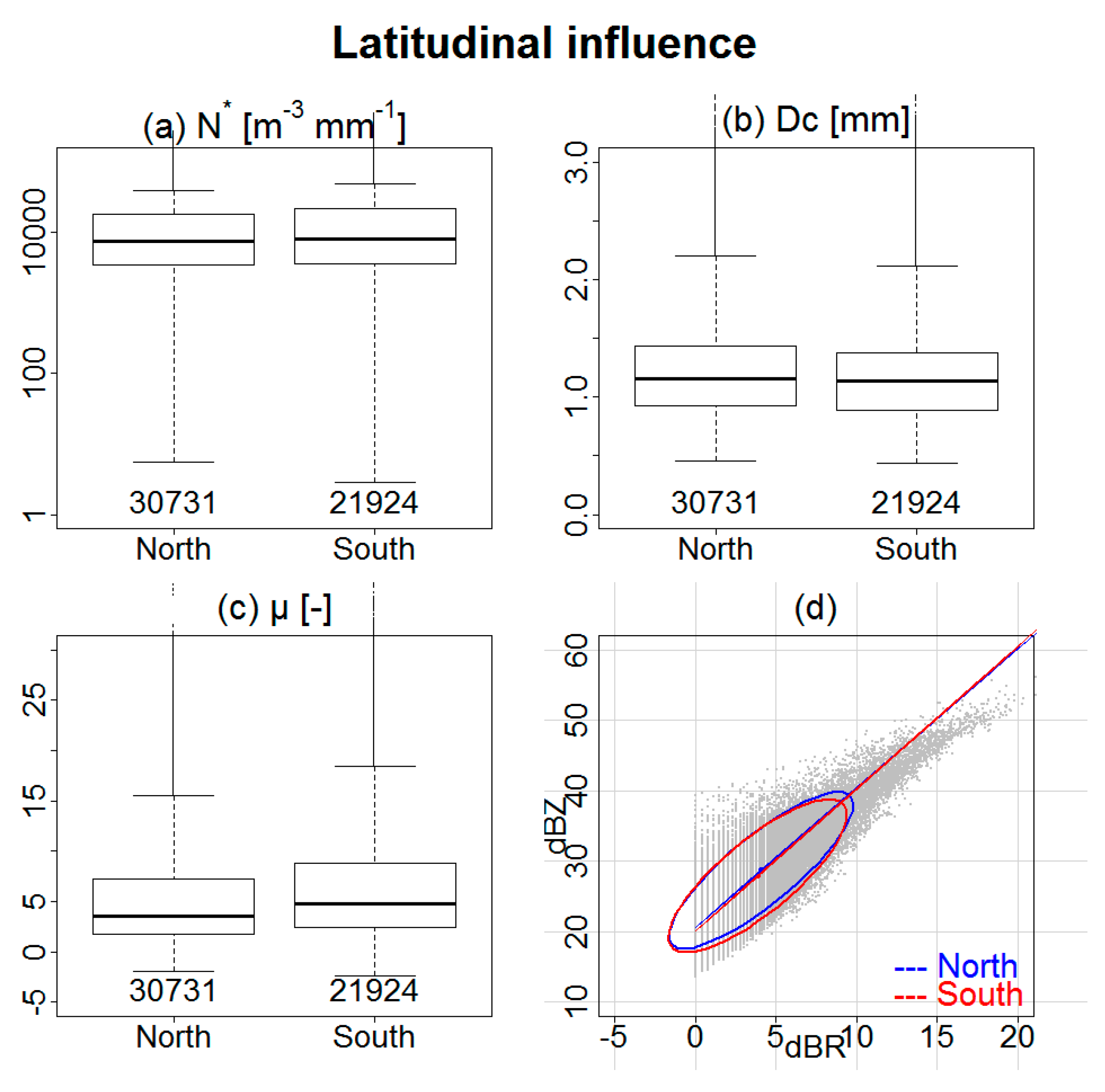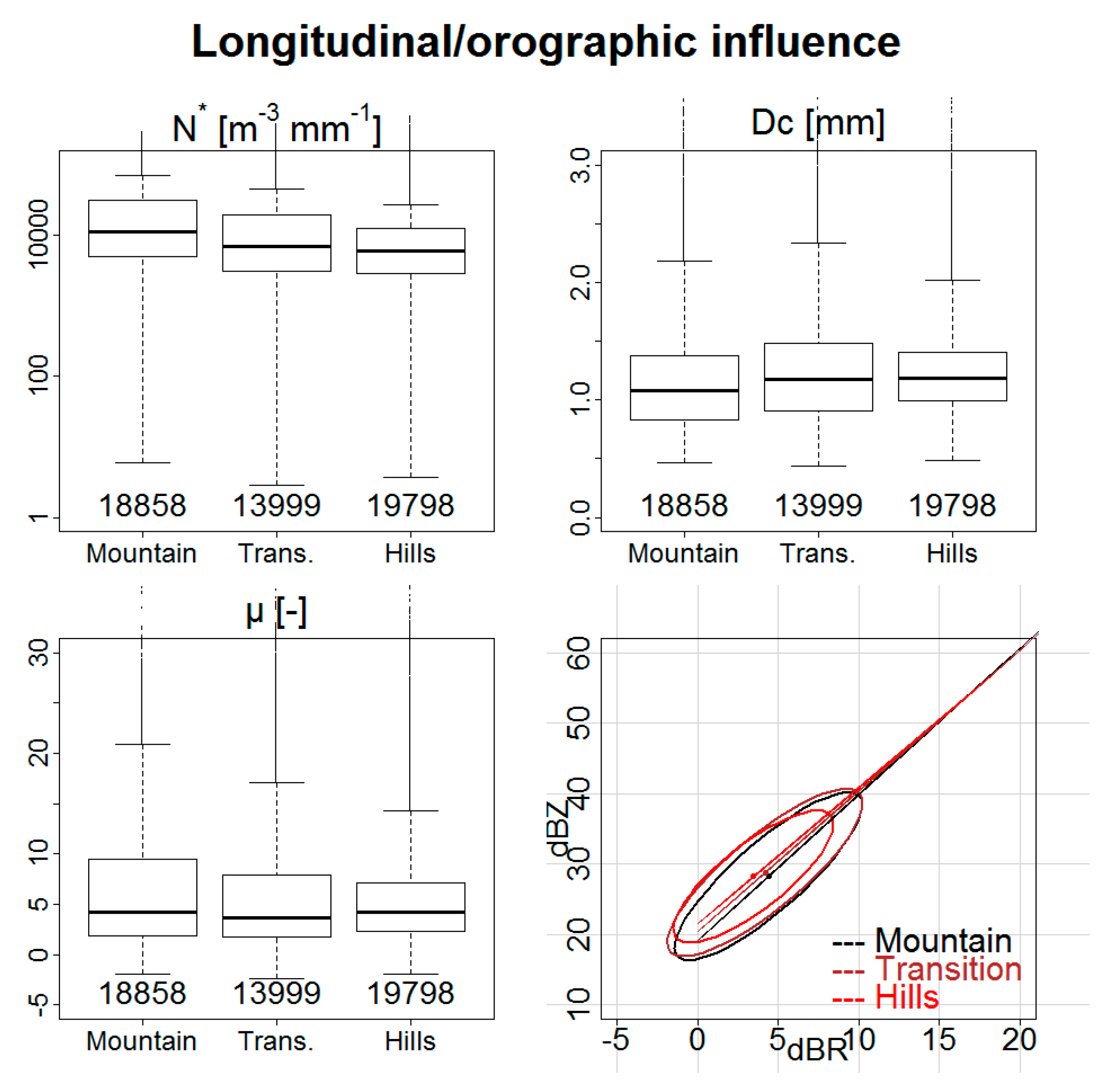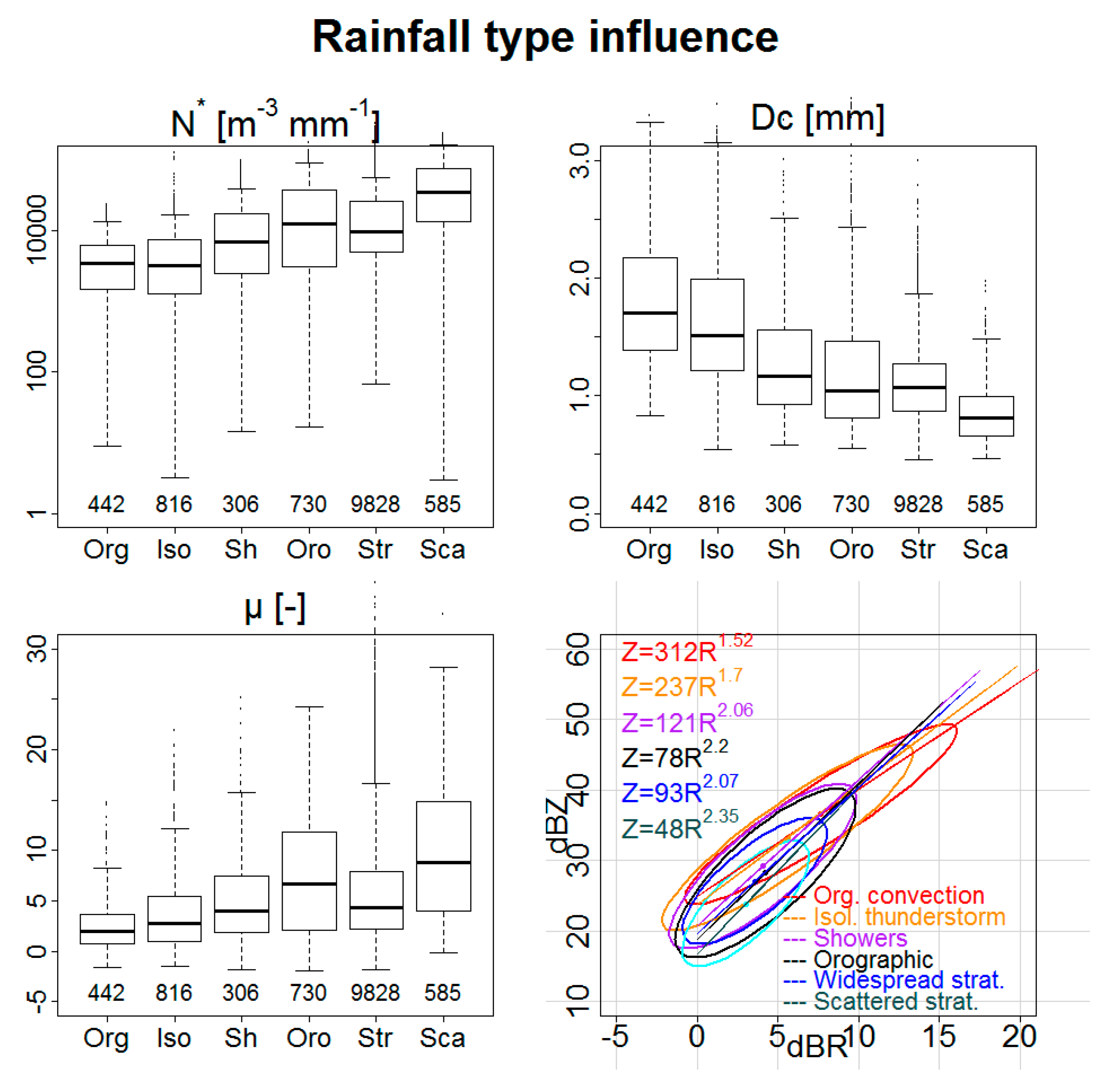Drop Size Distribution Climatology in Cévennes-Vivarais Region, France
Abstract
:1. Introduction
2. Data
2.1. Disdrometers Network
2.2. Data Availability, Checking, Filtering and Correction
- The first method (S1) used the raw DSD spectra (number of drops in 32 × 32 size/fall speed classes each record) without any correction or filtering.
- The last one (S3) was the “correction” method, proposed by [42]. This method consisted of applying pre-determined correction factors, depending on the intensities and the diameters that were estimated during inter-comparison measurement campaigns, using a 2DVD (used as a reference) and Parsivels of both generations. These campaigns took place between September and November, in both 2012 and 2013, in the Cévennes-Vivarais region, and between April and June 2014 in Payerne (Switzerland) [42].
3. DSD Descriptors and External Factors Studied
3.1. DSD Descriptors
3.2. External Factors Studied
3.2.1. Location
- (1)
- According to the proximity of the sea: data from La Souche, STEF, and Villeneuve stations have been put together to represent the climate of the north of the area, furthest from the Mediterranean Sea; data from Tourgueille, Valescure, and Alès have been put together to represent the south part of the area, where the Mediterranean character of the climate is more pronounced.
- (2)
- According to the proximity of the Cévennes mountains: data from La Souche and Tourgueille, which are located near mountain passes have been put together and labelled as “mountain”; data from Villeneuve and Alès, which are located in hilly areas in the plains have been put together and labelled as “hills”. Finally, the two remaining stations—STEF and Valescure—located, respectively, in the Ardèche valley and near the St Jean’s Gardon valley, have been labelled as “transition”.
3.2.2. Season
3.2.3. Daily Synoptic Weather Pattern (WP)
- WP1: Atlantic Wave (21% of rainy time steps)
- WP2: Steady Oceanic (10%)
- WP3: Southwest Circulation (7%)
- WP4: South Circulation (27%)
- WP5: Northeast Circulation (14%)
- WP6: East Return (4%)
- WP7: Central Depression (15%)
- WP8: Anticyclonic (2%)
3.2.4. Rainfall Type
- (1)
- Organized convective system (Org)
- (2)
- Isolated thunderstorms (Iso)
- (3)
- Showers (Sh)
- (4)
- Orographic rain (Oro)
- (5)
- Stratiform light rains (Str)
- (6)
- Scattered rain (Sca)
4. Results and Discussion
4.1. Location: Latitudinal and Longitudinal/Orographic Influences
4.2. Seasonal Influence
- (1)
- Distributions of Dc were almost identical in winter and spring. During these seasons, the dispersion of values is the lowest;
- (2)
- Distributions of μ were almost identical in spring and autumn; and
- (3)
- The concentration of drops was most similar in autumn and winter, when they were also highest (especially in winter).
4.3. Daily Weather Pattern Influence
- (1)
- WP3, 5, 6, and 8 are characterized by both lower concentrations, stronger characteristic diameters, and lower shape parameters;
- (2)
- WP1, 2, 4, and 7 that are characterized by higher concentrations, lower characteristic diameters (except for WP7 and slightly WP4 due to high dispersion) and more important shape parameters.
- WP8 (Anticyclonic) is the most particular of the first group, especially in terms of concentration (very low) and characteristic diameter (very large). This explains the shifted position towards the high Z values of the 80% confidence ellipse of this WP on Z-R plot. This type of weather, however, corresponds to weak occurrences of rain. The precipitating systems formed during this type of weather are generally small isolated thunderstorms.
- WP3 (Southwest Flow) brings more frequent precipitation to this region than WP8. It has similar, but less marked, characteristics.
- WP7 (Central Depression) brings high rainfall totals over the entire region. This is the only WP for which the concentration parameter is not anti-correlated with the characteristic diameter; drops are both numerous and large.
- WP5 (Northeast Circulation) corresponds to the smallest DSD variability. This WP brings very little precipitation over the region.
- Conversely, WP4 (South Circulation) is the one for which the DSD parameters are most variable. As it corresponds to a Southern flow in the lower layers, it favours incoming air masses from the sea and can trigger precipitation only on the first foothills of the reliefs.
4.4. Rainfall Type Influence
4.5. Combined Influences
4.5.1. Seasons and Locations
4.5.2. Weather Patterns and Locations
5. Conclusions
- (1)
- The distance from the Mediterranean Sea has a weak influence on DSD in the area considered in this study.
- (2)
- The summer season has larger drops, lesser concentration, and weaker shape parameters. Consequently, the Z-R relationship is quite different in this season, with a clear convective footprint (lower exponent and higher pre-factor).
- (3)
- The spring and fall season are transition seasons with hybrid characteristics between those of winter and summer. However, it was observed that there were differences between transition periods, according to DSD parameter: N* changes as early as spring, whereas Dc changes later in the summer season.
- (4)
- The weather patterns distinguish themselves in DSD characteristics and the Z-R relationship, but the differences are exacerbated in mountainous and transition areas, where the exposure of the site to atmospheric flow in the lower atmospheric layers particularly influences the shape parameter. The differences are attenuated in low altitude hilly areas.
- (5)
- The orographic environment also influences the size and concentration, depending on whether the site is located inside, close to, or far from mountainous areas, as found on one case study in [31].
- (6)
- The rainfall type strongly influences DSD characteristics and Z-R relationships. The convective rainfalls are particularly different than those usually found in the literature. This study proposes to detail a few more rainfall types, distinguishing six categories. A noteworthy gradation was found in the concentration, size, and shape parameters, according to the level of convection and organisation. Otherwise, the orographic precipitations present similar properties as showers for the characteristic diameter and the Z-R relationship. They are close to those of scattered rainfalls for concentration and shape parameter.
Acknowledgments
Author Contributions
Conflicts of Interest
References
- Frei, C.; Schär, C. A precipitation climatology of the Alps from high-resolution rain-gauge observations. Int. J. Climatol. 1998, 18, 873–900. [Google Scholar] [CrossRef]
- Tarolli, P.; Borga, M.; Morin, E.; Delrieu, G. Analysis of flash flood regimes in the North-Western and South-Eastern Mediterranean regions. Nat. Hazards Earth Syst. Sci. 2012, 12, 1255–1265. [Google Scholar] [CrossRef] [Green Version]
- Thiébault, S.; Moatti, J.P. (Eds.) The Mediterranean Region under Climate Change: A Scientific Update; AllEnvi: Marseille, France, 2016. [Google Scholar]
- Météo-France. Pluies extrêmes en France Métropolitaine. Available online: http://pluiesextremes.meteo.fr/ (accessed on 24 September 2017).
- Nuissier, O.; Ducrocq, V.; Ricard, D.; Lebeaupin, C.; Anquetin, S. A numerical study of three catastrophic precipitating events over southern France. I: Numerical framework and synoptic ingredients. Q.J.R. Meteorol. Soc. 2008, 134, 111–130. [Google Scholar] [CrossRef]
- Molinié, G.; Ceresetti, D.; Anquetin, S.; Creutin, J.D.; Boudevillain, B. Rainfall Regime of a Mountainous Mediterranean Region: Statistical Analysis at Short Time Steps. J. Appl. Meteorol. Climatol. 2012, 51, 429–448. [Google Scholar] [CrossRef]
- Froidurot, S.; Molinié, G.; Diedhiou, A. Climatology of observed rainfall in Southeast France at the Regional Climate Model Scales. Clim. Dyn. 2016, 1–19. [Google Scholar] [CrossRef]
- Ceresetti, D.; Molinié, G.; Creutin, J.D. Scaling properties of heavy rainfall at short duration: A regional analysis. Water Resour. Res. 2010, 46. [Google Scholar] [CrossRef]
- Miniscloux, F.; Creutin, J.D.; Anquetin, S. Geostatistical Analysis of Orographic Rainbands. J. Appl. Meteorol. 2001, 40, 1835–1854. [Google Scholar] [CrossRef]
- Berne, A.; Delrieu, G.; Boudevillain, B. Variability of the spatial structure of intense Mediterranean precipitation. Adv. Water Resour. 2009, 32, 1031–1042. [Google Scholar] [CrossRef]
- Ricard, D. Initialisation et Assimilation de Données à Méso-échelle Pour la Prévision à Haute Résolution des Pluies Intenses de la Région Cévennes-Vivarais. Ph.D. Thesis, Université Paul Sabatier-Toulouse III, Toulouse, France, December 2002. [Google Scholar]
- Godart, A.; Anquetin, S.; Leblois, E.; Creutin, J.D. The Contribution of Orographically Driven Banded Precipitation to the Rainfall Climatology of a Mediterranean Region. J. Appl. Meteorol. Climatol. 2011, 50, 2235–2246. [Google Scholar] [CrossRef]
- Marchi, L.; Borga, M.; Preciso, E.; Gaume, E. Characterisation of selected extreme flash floods in Europe and implications for flood risk management. J. Hydrol. 2010, 394, 118–133. [Google Scholar] [CrossRef]
- Boudevillain, B.; Delrieu, G.; Galabertier, B.; Bonnifait, L.; Bouilloud, L.; Kirstetter, P.E.; Mosini, M.L. The Cévennes-Vivarais Mediterranean Hydrometeorological Observatory database. Water Resour. Res. 2011, 47. [Google Scholar] [CrossRef]
- Delrieu, G.; Boudevillain, B.; Nicol, J.; Chapon, B.; Kirstetter, P.E.; Andrieu, H.; Faure, D. Bollène-2002 Experiment: Radar Quantitative Precipitation Estimation in the Cévennes-Vivarais Region, France. J. Appl. Meteorol. Climatol. 2009, 48, 1422–1447. [Google Scholar] [CrossRef]
- Zawadzki, I. Factors affecting the precision of radar measurements of rain. In Proceedings of the 22nd Conference on Radar Meteorology, Zurich, Switzerland, 10–13 September 1984; pp. 251–256. [Google Scholar]
- Chen, Y.; Takara, K.; Cluckie, I.D.; De Smedt, F.H. (Eds.) GIS and Remote Sensing in Hydrology, Water Resources and Environment; IAHS Publication: Wallingford, UK, 2004. [Google Scholar]
- Uijlenhoet, R. Raindrop size distributions and radar reflectivity-rain rate relationships for radar hydrology. Hydrol. Earth Syst. Sci. 2001, 5, 615–627. [Google Scholar] [CrossRef]
- Cerda, A. Rainfall drop size distribution in the Western Mediterranean basin, Valencia, Spain. CATENA 1997, 30, 169–182. [Google Scholar] [CrossRef]
- Yu, N.; Boudevillain, B.; Delrieu, G.; Uijlenhoet, R. Estimation of rain kinetic energy from radar reflectivity and/or rain rate based on a scaling formulation of the raindrop size distribution. Water Resour. Res. 2012, 48. [Google Scholar] [CrossRef]
- Angulo-Martínez, M.; Beguería, S.; Kyselý, J. Use of disdrometer data to evaluate the relationship of rainfall kinetic energy and intensity (KE-I). Sci. Total Environ. 2016, 568, 83–94. [Google Scholar] [CrossRef] [PubMed]
- Carollo, F.G.; Ferro, V.; Serio, M.A. Estimating rainfall erosivity by aggregated drop size distributions. Hydrol. Process. 2016, 30, 2119–2128. [Google Scholar] [CrossRef]
- Delrieu, G.; Creutin, J.D.; Saint-Andre, I. Mean KR Relationships: Practical Results for Typical Weather Radar Wavelengths. J. Atmos. Ocean. Technol. 1991, 8, 467–476. [Google Scholar] [CrossRef]
- Anagnostou, M.N.; Kalogiros, J.; Anagnostou, E.N.; Tarolli, M.; Papadopoulos, A.; Borga, M. Performance evaluation of high-resolution rainfall estimation by X-band dual-polarization radar for flash flood applications in mountainous basins. J. Hydrol. 2010, 394, 4–16. [Google Scholar] [CrossRef]
- Sempere-Torres, D.; Porrà, J.M.; Creutin, J.D. A General Formulation for Raindrop Size Distribution. J. Appl. Meteorol. 1994, 33, 1494–1502. [Google Scholar] [CrossRef]
- Cerro, C.; Codina, B.; Bech, J.; Lorente, J. Modeling Raindrop Size Distribution and Z(R) Relations in the Western Mediterranean Area. J. Appl. Meteorol. 1997, 36, 1470–1479. [Google Scholar] [CrossRef]
- Yu, N.; Delrieu, G.; Boudevillain, B.; Hazenberg, P.; Uijlenhoet, R. Unified formulation of single-and multimoment normalizations of the raindrop size distribution based on the gamma probability density function. J. Appl. Meteorol. Climatol. 2014, 53, 166–179. [Google Scholar] [CrossRef]
- Caracciolo, C.; Porcu, F.; Prodi, F. Precipitation classification at mid-latitudes in terms of drop size distribution parameters. Adv. Geosci. 2008, 16, 11–17. [Google Scholar] [CrossRef]
- Sempere-Torres, D.; Sanchez-Diezma, R.; Zawadzki, I.; Creutin, J.D. Identification of stratiform and convective areas using radar data with application to the improvement of DSD analysis and Z-R relations. Phys. Chem. Earth 2000, 25, 985–990. [Google Scholar] [CrossRef]
- Chapon, B.; Delrieu, G.; Gosset, M.; Boudevillain, B. Variability of rain drop size distribution and its effect on the Z-R relationship: A case study for intense Mediterranean rainfall. Atmos. Res. 2008, 87, 52–65. [Google Scholar] [CrossRef]
- Hazenberg, P.; Yu, N.; Boudevillain, B.; Delrieu, G.; Uijlenhoet, R. Scaling of raindrop size distributions and classification of radar reflectivity–rain rate relations in intense Mediterranean precipitation. J. Hydrol. 2011, 402, 179–192. [Google Scholar] [CrossRef]
- Zwiebel, J.; Van Baelen, J.; Anquetin, S.; Pointin, Y.; Boudevillain, B. Impacts of orography and rain intensity on rainfall structure. The case of the HyMeX IOP7a event. Q. J. R. Meteorol. Soc. 2016, 142, 310–319. [Google Scholar] [CrossRef]
- Ducrocq, V.; Braud, I.; Davolio, S.; Ferretti, R.; Flamant, C.; Jansa, A.; Kalthoff, N.; Richard, E.; Taupier-Letage, I.; Ayral, P.A.; et al. HyMeX-SOP1: The field campaign dedicated to heavy precipitation and flash flooding in the Northwestern Mediterranean. Bull. Am. Meteorol. Soc. 2014, 95, 1083–1100. [Google Scholar] [CrossRef]
- Löffler-Mang, M.; Joss, J. An Optical Disdrometer for Measuring Size and Velocity of Hydrometeors. J. Atmos. Oceanic Technol. 2000, 17, 130–139. [Google Scholar] [CrossRef]
- Tokay, A.; Wolff, D.B.; Petersen, W.A. Evaluation of the New Version of the Laser-Optical Disdrometer, OTT Parsivel2. J. Atmos. Ocean. Technol. 2014, 31, 1276–1288. [Google Scholar] [CrossRef]
- Bousquet, O.; Berne, A.; Delanoe, J.; Dufournet, Y.; Gourley, J.; Van-Baelen, J.; Augros, C.; Besson, L.; Boudevillain, B.; Caumont, O.; et al. Multifrequency Radar Observations Collected in Southern France during HyMeX-SOP1. Bull. Am. Meteorol. Soc. 2015, 96, 267–282. [Google Scholar] [CrossRef] [Green Version]
- Nord, G.; Boudevillain, B.; Berne, A.; Branger, F.; Braud, I.; Dramais, G.; Gérard, S.; Le Coz, J.; Legoût, C.; Molinié, G.; et al. A high space-time resolution dataset linking meteorological forcing and hydro-sedimentary response in a mesoscale Mediterranean catchment (Auzon) of the Ardèche region, France. Earth Syst. Sci. Data 2017, 9, 221–249. [Google Scholar] [CrossRef]
- Observatoire Hydrométéorologique Méditerranéen Cévennes-Vivarais. Available online: http://www.ohmcv.fr/ (accessed on 5 November 2017).
- Hydrological Cycle in Mediterranean Experiment. Available online: http://www.hymex.org/ (accessed on 5 November 2017).
- Jaffrain, J.; Studzinski, A.; Berne, A. A network of disdrometers to quantify the small-scale variability of the raindrop size distribution. Water Resour. Res. 2011, 47. [Google Scholar] [CrossRef]
- Beard, K.V. Terminal Velocity Adjustment for Cloud and Precipitation Drops Aloft. J. Atmos. Sci. 1977, 34, 1293–1298. [Google Scholar] [CrossRef]
- Raupach, T.H.; Berne, A. Correction of raindrop size distributions measured by Parsivel disdrometers, using a two-dimensional video disdrometer as a reference. Atmos. Meas. Tech. 2015, 8, 343–365. [Google Scholar] [CrossRef]
- Testud, J.; Oury, S.; Black, R.A.; Amayenc, P.; Dou, X. The Concept of “Normalized” Distribution to Describe Raindrop Spectra: A Tool for Cloud Physics and Cloud Remote Sensing. J. Appl. Meteorol. 2002, 40, 1118–1140. [Google Scholar] [CrossRef]
- Atlas, D.; Srivastava, R.; Sekhon, R.S. Doppler radar characteristics of precipitation at vertical incidence. Rev. Geophys. 1973, 11, 1–35. [Google Scholar] [CrossRef]
- Bolle, H.J. (Ed.) Mediterranean Climate: Variability and Trends; Springer: Berlin, Germany, 2002. [Google Scholar]
- Garavaglia, F.; Gailhard, J.; Paquet, E.; Lang, M.; Garçon, R.; Bernardara, P. Introducing a rainfall compound distribution model based on weather patterns sub-sampling. Hydrol. Earth Syst. Sci. 2010, 14, 951–964. [Google Scholar] [CrossRef] [Green Version]
- Froidurot, S. Approche Multi-échelle Pourl’évaluation de la Pluie dans les Modèles Climatiques Régionaux. Étude dans le Sud-est de la France. Ph.D. Thesis, Université Grenoble Alpes, Grenoble, France, November 2015. [Google Scholar]
- Figueras i Ventura, J.; Tabary, P. The New French Operational Polarimetric Radar Rainfall Rate Product. J. Appl. Meteorol. Climatol. 2013, 52, 1817–1835. [Google Scholar] [CrossRef]
- Rosenfeld, D.; Ulbrich, C.W. Cloud microphysical properties, processes, and rainfall estimation opportunities. In Radar and Atmospheric Science: A Collection of Essays in Honor of David Atlas; Wakimoto, R.M., Srivastava, R., Eds.; American Meteorological Society: Boston, MA, USA, 2003. [Google Scholar]










| ID 1 | Name | Location | Altitude | Disdrometer | Environment |
|---|---|---|---|---|---|
| SOU | La Souche | 44.63° N; 4.12° E | 920 m | OTT Parsivel2 | mountains |
| SEF | StEF | 44.60° N; 4.38° E | 210 m | OTT Parsivel2 | transition |
| VB1 | Villeneuve | 44.55° N; 4.50° E | 300 m | OTT Parsivel2 | hills |
| TOU | Tourgueille | 44.13° N; 3.66° E | 540 m | OTT Parsivel2 | mountains |
| VAL | Valescure | 44.09° N; 3.84° E | 480 m | OTT Parsivel2 | transition |
| ALE | Alès | 44.14° N; 4.10° E | 150 m | OTT Parsivel | hills |
© 2017 by the authors. Licensee MDPI, Basel, Switzerland. This article is an open access article distributed under the terms and conditions of the Creative Commons Attribution (CC BY) license (http://creativecommons.org/licenses/by/4.0/).
Share and Cite
Hachani, S.; Boudevillain, B.; Delrieu, G.; Bargaoui, Z. Drop Size Distribution Climatology in Cévennes-Vivarais Region, France. Atmosphere 2017, 8, 233. https://doi.org/10.3390/atmos8120233
Hachani S, Boudevillain B, Delrieu G, Bargaoui Z. Drop Size Distribution Climatology in Cévennes-Vivarais Region, France. Atmosphere. 2017; 8(12):233. https://doi.org/10.3390/atmos8120233
Chicago/Turabian StyleHachani, Sahar, Brice Boudevillain, Guy Delrieu, and Zoubeida Bargaoui. 2017. "Drop Size Distribution Climatology in Cévennes-Vivarais Region, France" Atmosphere 8, no. 12: 233. https://doi.org/10.3390/atmos8120233





